Vehicle History | VW Mk1 Golf


Despite popular belief, the Golf isn't named after the game, an understandable mistake to make when you think of the Polo, but is in fact named after a wind, the word being German for the Gulf stream, the rest of the VW range at the time followed suit with Scirocco, Jetta and Passat all sharing the same naming convention. Another common misconception is that the Beetle is VW's best selling model, again this is incorrect, with the Golf having achieved sales of over 25 million, by 2007, being the 3rd best selling car in the world.
Officially introduced in May 1974, the Guigiaro designed Mk1 Golf (codenamed Typ 17) was set to be Volkswagen’s replacement for the legendary Beetle, however the Golf wasn't VW's first attempt at trying to replace the Beetle, but all the predecessors had fallen way short of achieving the production figures set by the Beetle. This time though, the two designs couldn't have been more different, the Beetle had been of a traditional chassis and body two piece construction, the Golf was a monocoque design (meaning the body and chassis were one in the same).
The Beetle had employed fairly basic suspension based around a beam axle at the front, whereas the Golf used MacPherson struts (as designed by Earle S MacPherson, Chevrolet's head of engineering in the late 1940's). The Golf used a unique trailing arm Independent rear suspension; the Beetle on the other hand relied on a swing axle, then latterly a form of Independent rear unit. In terms of propulsion, the Beetle had utilized an air-cooled flat four mounted in the rear of the car, hung off the gearbox, behind the axle driving the rear wheels, conversely the Golf made use of a water-cooled inline 4 cylinder, transversely mounted ahead of the front axle, driving the front wheels. This design allowed maximum use of the space created within the footprint of the car.
The passenger compartment was positively spacious by comparison to the Beetle (as well as the rest of the Golfs peers), and luggage capacity was leagues ahead, with the option to be extended further into the cabin by folding the rear seats down. If ever a car was going to the follow on the legacy of the Beetle, the little Golf was certainly well prepared for it
One key factor however remained the same between the two cars; the design, layout and theory of both cars were as efficient as they possibly could be taking into account the technology of the time. Testament to this is the fact that the Beetle remained in production, largely unchanged for another 4 decades after the launch of the Golf (by which time the Golf was in its 4th incarnation).
6 months before the launch of the Golf, VW unveiled the Mk1 Scirocco to the public, originally conceived as a replacement to the Karmann Ghia (which makes sense when you consider the relationship between the Beetle and Ghia, then respectively the Golf and Scirocco) the car was most definitely based on the Golf, but had been substantially re-engineered to provide a more sporty and satisfying driving experience. The reasoning behind launching the Scirocco first was effectively as a guinea pig, it gave VW the chance to monitor and react to any potential teething problems attached to their new baby (the Golf) before unleashing it on a market that might not have been as understanding as the Scirocco owner.
Whilst also sketched out by Italian Giugiaro, the Scirocco was to be built in Osnabruck at Karmann's factory there. The car achieved silver screen success in the original 1978 version of George Romero's "Dawn of the Dead". The earliest Golfs are distinguishable by their distinctive “Swallow-Tail” rear panels, which dip down beneath the license plate, and their smooth bonnets. These early models are now increasingly sought after, and will doubtless become the “oval window Beetle” of the Golf scene. In 1975 the Golf achieved the accolade of "Car of the Year" chosen by Wheels magazine.
With its light weight, precise steering, and confidence inspiring road manners the new small VW soon set standards for what a small car should be like. This combined with the fact it was keenly priced, led to sales far outstripping that of VW's expectations, convincing even the most sceptical that here was a car that was going to be the replacement for the venerable Beetle.
Who could have predicted the global success and multitude of imitators (what is it they say about imitation?) that the result of a few engineers after hours work could have spawned? Whilst the idea of a "sporty" saloon was hardly a new one, with both Ford, and Triumph previously having a go at making a sporty practical car with the Lotus Cortina, RS Escorts and Dolomite Sprint respectively, It took Volkswagen to turn It Into a real success. It really was the car that coined the term "Hot-Hatch".
The "Sport Golf" as it was known back then had been concocted by a few of VW's senior engineers as an after work project, made from various parts pinched from the VW parts bin, the original 1471cc engine had been bored out from 76.5mm to 79.55mm producing a 1588cc engine which rather conveniently had been developed for the Audi 80GT, fuelled by a twin choke Solex carb the engine produced 100bhp.
A new larger diameter clutch was fitted, gear ratios were improved, and vented front disc brakes were fitted along with a larger diameter servo, ride height was lowered 20mm over the standard car, and new wider (5.5") steel wheels were wrapped in 175 section tyres. In May 1975 approval was granted to produce 5000 units (the minimum required for competing in production motorsport).
The Sport Golf was given its new name, the Golf GTI, and fitted with Bosch K-Jetronic fuel injection, which had been robbed from the USDM Audi 80, ironically a system which had been introduced to control emissions and improve economy was now being used in the pursuit of more power and performance. There is some debate as to what the GTI stood for, whilst it's not doubted that the GT is in reference to Grand Tourer/Gran Turismo, if you were to follow that up with the German word for injection, you'd have Einspritzung, and thus GTE, a tag already coined by Audi and latterly Vauxhall/Opel, some people suggest that with Audi having already chosen the GTE moniker,
VW wanted to be different and used GTi, with others suggesting that it was based on the Italian, Gran Turismo Iniezione, in reference to the Golfs original designer, Guigiaro. With its new found 110bhp the 827 engine needed additional cooling, but this wasn't an issue, a Beetle oil cooler was just stuck on top of the gearbox.
A LATE MODEL MK1 GOLF GTI
Fitted with the distinctive Pirelli 'P Slot' alloy wheels.
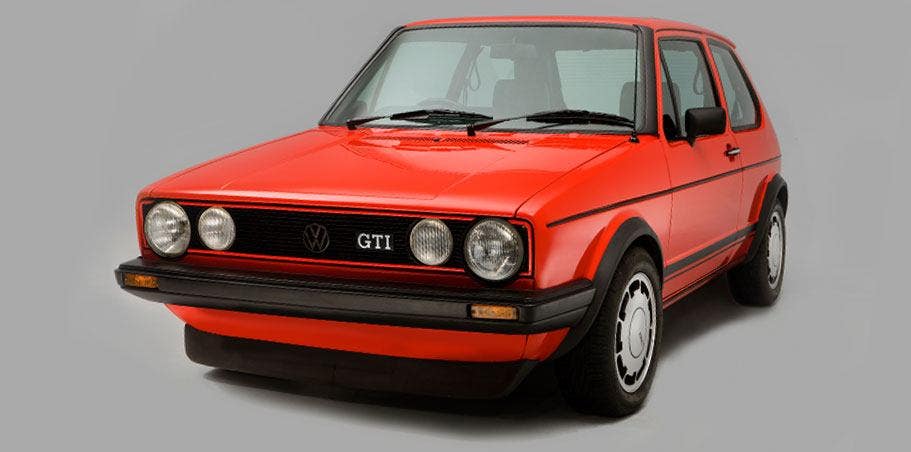

The GTI was unveiled to the general public and motoring press at the September 1975 Frankfurt Motor Show, the car however wasn't available to buy until June 1976 due to the engineers insistence that the new GTI should satisfy the same levels of quality and reliability that every production VW adhered to, a commitment that almost certainly lead to the longevity of the GTI when compared to its peers such as the XR3, Astra GTE and Peugeot 205 GTI.
Available in any colour so long as it was Mars Red, or Diamond Metallic Silver, customers were offered the choice of Schwartz Black soon after launch. The GTI was first granted a UK audience in late 1976, at the London Motor Show, where VW stated that there would be no RHD version, citing technical reasons as the reason, however you could import a LHD one as special order if you so chose at a cost of £3,372.
A few companies within the UK were beginning to specialise in making their own GTI's using RHD 1500cc Golfs as the basis, notably GTI Engineering and Tim Stiles. Following relentless lobbying by the UK dealer network, VW finally offered a RHD version of the GTI in early 1979, something they probably should have done earlier, especially when you compare sales of the '78 LHD GTI at 22, vs. the '79 RHD GTI with over 1500 sold.

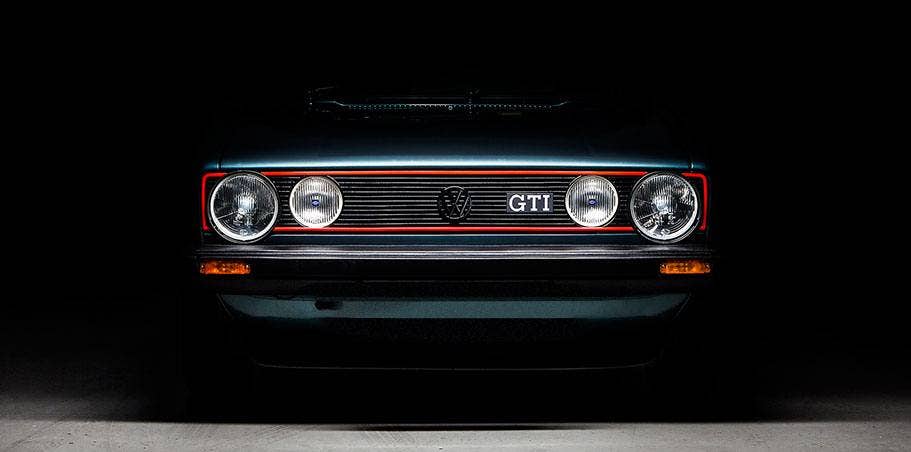
THE FACE THAT STARTED THE CRAZE...
The Mk1 Golf's signature red striped grille.
The 1979 Mk1 GTI featured the new style plastic wraparound bumpers which had replaced the basic metal rail type affairs which the earlier cars had been fitted with. In January 1980 the GTI was fitted with a new close ratio 5 speed gearbox, and September 1980 saw the introduction of the "series 2" dashboard, with LED warning lights, new dials, a digital clock, and extra air vents, the interior trim changed from the checked design to a more contemporary striped pattern. A year later the upgrades included the larger rear clusters, different door pulls, and bigger door pockets.
September 1982 brought the GTI's first major engine change with capacity increased from 1588cc to 1781cc, whilst this had a negligible effect on overall power, torque was increased resulting in improved 0-60 times, and a marginally improved top speed. Interior wise, the MFA we've all come to expect in GTIs was introduced, essentially an on-board computer which could measure fuel economy, distance, fuel range, engine temperatures and external temperatures, it was pretty advanced for 1982!


DETAILS DETAILS
Mk1 Golf GTi interior (Left) - Note the Golf ball gearnob. Mk1 Golf Pirelli 'P Slot' alloy wheels (Right).
The 1983 model year was the final year for the Mk1 GTI, and VW marked it by producing the Campaign edition cars (marketed as the Pirelli Edition In Europe), essentially a rather cynical marketing job by VW to shift the remaining Mk1 GTI's before the introduction of the Mk2, the car was in layman’s terms a Mk1 GTI with all the option boxes ticked, including; a sunroof, 14" Pirelli Alloys, Four Headlamp Grille, tinted glass, metallic paint, and a leather trimmed grille, these cars are now viewed as highly desirable amongst fans of the Mk1 GTI.
Launched in 1975 the US, the Rabbit (as it was known over there) was fast becoming a force to be reckoned with, and was really the only car capable of bringing the fight to the influx of new Japanese compact cars, whilst the overall look of the car was fairly similar to its European market sibling, there were differences, with impact bumpers adding both visually and literally a few pounds to the little Rabbits waistline, as well as increasing the weight by a few kilo's. The US market cars were still produced on the same production line as the Euro market models, but this was set to change within a few years.
For the start of the 1979 model year production of the Rabbit was shifted to the Westmoreland plant in Pennsylvania, the plant had formerly been a Chrysler production facility, with VW using the shell as a starting point. As well as being a historic moment for VW, it also signified the first major manufacturing plant in the US by a non-domestic marque. This in turn opened the doors for Toyota, Honda as well as BMW and Mercedes to establish their own industrial presence within the US.
The new models were easily distinguishable from their European produced counterparts with the introduction of an entirely new front end design, featuring different grilles, and new square headlamps and as we have come to expect with USDM cars, the suspension had been softened for the US consumer. Initially production was shared between Wolfsburg, and Westmoreland, the two models parentage was easily recognisable by the difference in the front ends, but before long all petrol powered Rabbits were produced on US soil, with only the diesel cars being imported.
1981 heralded another facelift for the diminutive VW, the front wings were changed to incorporate "wrap-around" indicators, and the even chunkier plastic bumpers reflected the latest changes in the US Governments ceaseless efforts to improve passenger safety. In 1983, nearly a full 10 years after the launch in Europe, America got its first GTi. Whilst slower than its Euro counterpart, the new Rabbit GTi still represented a serious performance increase over the stock Rabbit and was set to become a big success. 1984 was the last year of Rabbit production as the factory geared up to produce the new Golf Mk2.
OTHER MK1 INCARNATIONS
Over time many other models came to be based on the original Golf platform. Cabrio (Typ 155) The Golf Cabrio was first presented to VW by Karmann in December 1976, it was essentially the same car we know now as the Golf Cabrio, but was lacking the trademark rollbar, there is some confusion as to when the first models were produced with some sources saying September '78 and others suggesting February '79, the car was first unveiled at the Geneva motor show in March '79. The cabrio was launched to the European market in July 1979, and followed onto the US market as a 1980 model year car, badged as a Rabbit Convertible.
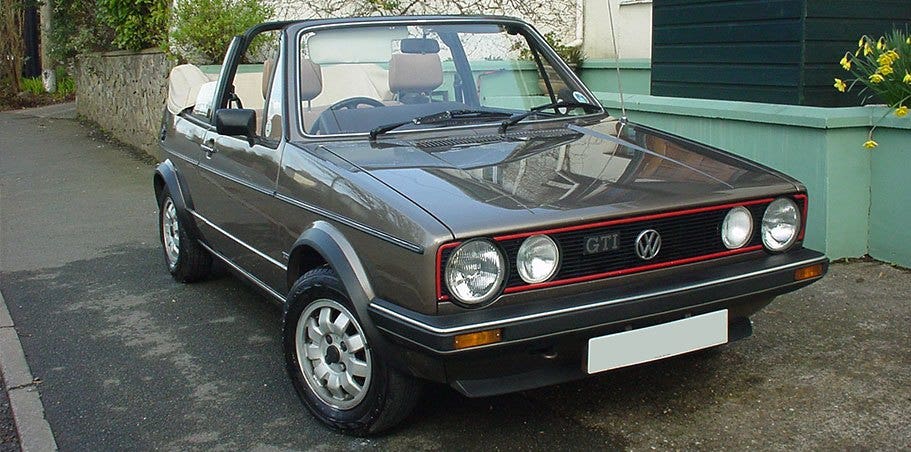

MK1 GOLF CABRIOLET
A Completely standard example of a Mk1 Golf Gti Cabriolet
The car was built entirely at Karmann's facility in Osnabruck, with VW supplying the interiors and running gear to be bolted to the in-house manufactured body. Engines were offered in pretty much every format that the hard top Golf had received (1100-1800cc, both carb. and injected) with the exception of the diesel, and a Mk2 8v style Digifant 1800 8v which was offered in the US.
The car remained essentially unchanged until 1982, when the hood design was altered so that it folded flatter, to aid rear visibility. In 1984 the cabrio was subjected to a few updates, to drawer it more in line with the newly launched Mk2 Golf, so the rear seat received a "split" type design, and the fuel tank was increased from 40-55L with the addition of a space-saver type spare wheel. Alongside the new fuel tank, the fuel pump was located within the tank, as opposed to the externally mounted item on earlier cars.
The next big update for the cabrio was to come in 1988 when the Clipper body kit was fitted, this comprised of smooth rather than textured deeper bumpers, which flowed into extended wheel arch trims, which in turn met side skirts leading into similar rear bumpers. The front grille was redesigned to reflect the updated Mk2 Golf grille, and had been fitted with the twin spotlights synonymous with the GTI models. In June 1991 the little cabrio took the accolade of being the world’s most popular convertible car, with Karmann confirming 388,522 cabrios being produced between 1979 and 1991.
April 1993 saw the end of the line for the cabrio, with the introduction of the Mk3 Cabrio, the Mk1 had outlasted its younger brother in the form of the Mk2, and the final versions being labelled "Sportline" available in Red or Black, fitted with black centred BBS RA alloys, and a black and red Recaro interior with red painted dial needles, or the "Rivage" which was sold as the luxury version, fitted with heated seats, often trimmed in leather, available in green, or blue, both models are highly sought after today.
JETTA (TYP 161)
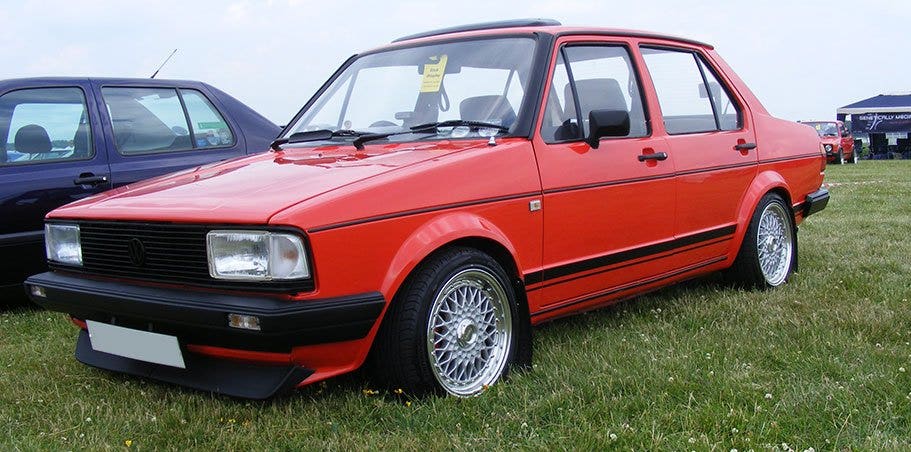

Following on from the success of the Rabbit on the US market, VW noticed that the American consumers seemed to prefer the "3 box" saloon style of car over the hatchback, reacting to this VW went back to Guigiaro requesting he amended the design of the Golf to produce a saloon version. Available as a 4 door in the UK, a 2 door Coupe version was available in Europe and the US. To distinguish the Jetta from its smaller sibling the interiors were designed to appear more upmarket, with velour interiors and full carpeting.
All Jettas sold in the US were produced in Germany unlike the Rabbit, which was being produced in Westmoreland by then, VW had looked into a Jetta production facility in Michigan, but the decision was abandoned following a drop in sales, even though the Jetta was at one point the best selling European car on the US, Canadian and Mexican markets. Jettas were produced outside of Germany though, specifically at the TAS (Tvornika Automobia Sarajevo) plant in Bosnia for sale into the Balkan states.
CADDY (TYP 147)
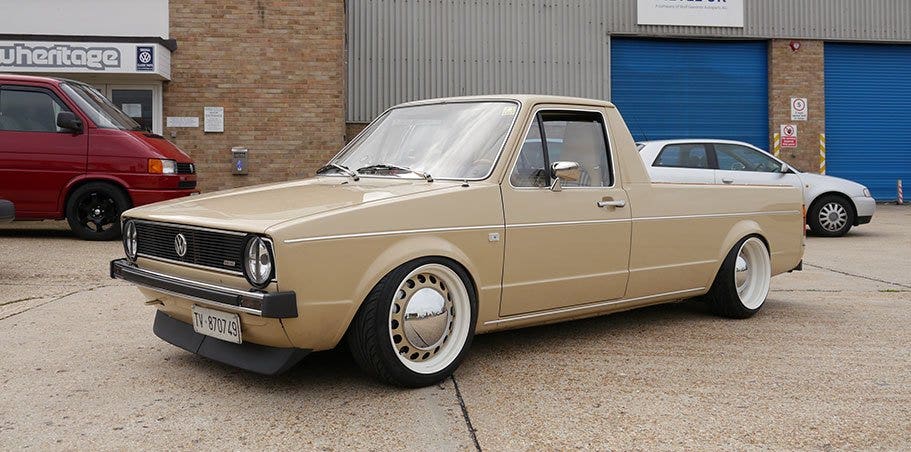

The Caddy was launched in 1980 as part of VW's ongoing development into derivatives based on the Mk1 Golf platform. VW of America expressed an interest in the new "mini-pickup", and production began at the Westmoreland plant. The Caddy as it's known in Europe was never badged as such in the US, due to the term being used to refer to Cadillac cars, and it was always referred to as the Rabbit Pickup.
In 1982 production of the Caddy began at the TAS plant in Sarajevo, and this is where all Euro market Caddys were produced all the way up until the Caddy was axed from VW's line-up. The pressing equipment was moved from Westmoreland and shipped out to South Africa, where production of the Caddy continued for the domestic market well into the 21st Century. This signalled the end of the Westmoreland plant under VW's ownership, and it's now being used by Sony to produce TVs.
CITI GOLF (TYP 17S)
The Citi Golf was produced by VW South Africa from 1984, the tooling was shipped from Westmoreland, the car underwent some subtle styling changes, including a new grille, similar to that of the Mk2, deeper bumpers and a swage was pressed into the C pillar, the car was only ever produced as a 5 door. Early versions were offered in a range of basic solid colours (red, yellow and blue) with white bumpers. The car underwent several styling updates, involving new more modern bumpers, and fresher interiors (including the fitting of a Skoda Fabia dash in 2004).
Numerous special edition Citi Golfs were produced including the Deco (essentially a VWSA take on the Colour Concept, with colour coded leather upholstery) and the VeloCiti, which included the Citi 1.8iR, launched in 2006, it featured a half leather Interior, aluminium trim, an 1800cc fuel Injected engine, as well as alloys very similar to that of the Lupo GTI and a full body kit. August 21st 2009 brought Citi Golf production to an end after 25 years, marked with one final limited edition, the Citi Mk1, essentially a run-out model featuring all the options, and numbered plaques running up to 1000.




 Beetle
Beetle
 Type 2 Bay
Type 2 Bay
 Type 2 Split
Type 2 Split
 Type 25
Type 25
 Transporter T4
Transporter T4
 Transporter T5
Transporter T5
 Golf Mk1
Golf Mk1
 Golf Mk2
Golf Mk2


 911
911
 996
996
 997
997
 986 Boxster
986 Boxster
 987 Boxster
987 Boxster
 912
912
 944
944
 924
924


 Defender
Defender
 Discovery Series 1
Discovery Series 1
 Discovery 2
Discovery 2
 Series 1, 2 & 3
Series 1, 2 & 3
 Freelander
Freelander
 Freelander 2
Freelander 2




